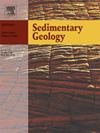Aeolian–fluvial interactions within a fault-controlled basin: Late Cretaceous Chaling Basin, South China
IF 2.9
2区 地球科学
Q1 GEOLOGY
引用次数: 0
Abstract
The Upper Cretaceous Daijiaping Formation of the Chaling Basin, southeast China, is a mixed aeolian–fluvial succession accumulated in an erg-margin setting. The roles of climate and tectonics in governing the temporal and spatial arrangement of aeolian and fluvial strata are investigated using lithofacies and architectural-element analyses of outcrops in the eastern part of the basin. Architectural elements of aeolian origin record the preserved expression of dunes, sandsheets, damp and wet interdunes, and sand pods. Architectural elements of alluvial origin record channelized bedload streams and cobble-sand sheetflow units. Distinctive deflation lags and desert pavements are also recognized. The alternating nature of deposition via aeolian and aqueous processes is marked by a series of sand-drift surfaces that form a record of repeated shifts from aeolian to water-lain depositional conditions. Ephemeral water influx to the desert-margin system likely occurred in response to exceptional rainfall caused by monsoonal water discharge and meltwaters from glaciated mountain ranges that bordered the basin. The vertical arrangements of alternating facies associations define stacked wetting-upward cycles, each 0.4–14.2 m thick. Each cycle commences with simple or compound crescentic dune deposits, else with aeolian sandsheet deposits. These are overlain by bedload stream or conglomerate sheetflow deposits. The vertical stacking of these different architectural elements records the contraction and expansion of erg-margin systems in response to climate-controlled variations in the groundwater level, sand availability for aeolian transport, and fluvial and aeolian sediment transport capacity. The stratigraphic evolution was controlled by exceptional rainfall events at the basin margin, consequent floods into the dune-field margin and associated fluctuations in the water-table level. Orogenic uplift, a subtropical high-pressure system, and a variable groundwater level controlled by a monsoon climate and tectonic subsidence resulted in the development of extensive aeolian desert depositional systems in the South China hinterland during the Late Cretaceous.
断控盆地内风成—河流相互作用:晚白垩世茶令盆地
茶陵盆地上白垩统戴家坪组是一个在边缘环境下形成的风成—河流混合序列。通过对盆地东部露头的岩相和建筑元素分析,探讨了气候和构造在控制风成地层和河流地层时空排列中的作用。风成的建筑元素记录了沙丘、沙层、潮湿的沙丘间和沙舱的保存状态。冲积起源的建筑元素记录了河道化的河床流和卵石砂片流单元。独特的通货紧缩滞后和沙漠路面也是公认的。风沙沉积和水沉积交替的特点是一系列的沙流表面,这些沙流表面记录了从风沙沉积到水沉积条件的反复转变。短暂的水流入沙漠边缘系统可能是由于季风降水和与盆地接壤的冰川山脉的融水造成的异常降雨造成的。交替相组合的垂直排列定义了堆叠的润湿向上旋回,每个厚度为0.4-14.2 m。每个旋回开始于简单或复合新月形沙丘沉积,或开始于风成沙板沉积。它们被层载流或砾岩片流沉积物覆盖。这些不同建筑元素的垂直堆叠记录了湿地边缘系统的收缩和扩张,以响应气候控制的地下水位变化、风沙运输的可用性以及河流和风沙运输能力。地层演化受盆地边缘异常降雨事件、随后流入沙丘场边缘的洪水以及与之相关的地下水位波动的控制。晚白垩世,造山隆升、副热带高压系统、季风气候和构造沉降控制下的多变地下水位,形成了华南腹地广泛的风成沙漠沉积体系。
本文章由计算机程序翻译,如有差异,请以英文原文为准。
求助全文
约1分钟内获得全文
求助全文
来源期刊

Sedimentary Geology
地学-地质学
CiteScore
5.10
自引率
7.10%
发文量
133
审稿时长
32 days
期刊介绍:
Sedimentary Geology is a journal that rapidly publishes high quality, original research and review papers that cover all aspects of sediments and sedimentary rocks at all spatial and temporal scales. Submitted papers must make a significant contribution to the field of study and must place the research in a broad context, so that it is of interest to the diverse, international readership of the journal. Papers that are largely descriptive in nature, of limited scope or local geographical significance, or based on limited data will not be considered for publication.
 求助内容:
求助内容: 应助结果提醒方式:
应助结果提醒方式:


